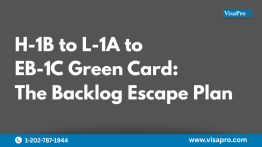Introduction
H-1B Roving Employees require special attention and analysis. In general, if an employer sends an H-1B worker to a new worksite, not listed on the Labor Condition Application (LCA), the employer must act to maintain compliance with both DOL and USCIS regulations and rules. Here, we focus on maintaining LCA compliance when there is a change in location. Check out this article for information on what to do when a change in location requires an H-1B Amendment.
Place of Employment
The DOL regulations include a detailed definition of ‘place of employment’. Place of employment is the actual worksite or location where the H-1B employee actually works. This definition governs what an employer must do to maintain LCA compliance when there is a possible change in work location.
The definition also creates several exceptions that are not considered new places of employment, such as places where an H-1B may travel temporarily for developmental activity or to receive training. If there is no new ‘place of employment,’ then the employer’s LCA obligations remain fixed at the home base.
The Employer’s Obligation When A H-1B Roving Employee Goes To A New Place Of Employment
Generally, if an H-1B roving employee is going to a new ‘place of employment’ or ‘worksite’, then the employer must do one of the following:
- For worksites that are within the same geographical area of intended employment (within the same MSA or within commuting distance of the original location), then the employer must re-post notice of the LCA at the new worksite for 10 business days on or before the day H-1B begins work there;
- Use the short-term placement rules; or
- File a new LCA for the new worksite (which would automatically require an H-1B Amendment).
Exception to the above:
The employer is not required to take one of the above three steps to maintain compliance in the case of ‘peripatetic’ workers and workers who travel occasionally on a casual short-term basis.
The regulations define a type of H 1B employee whose work is ‘peripatetic’ in nature. Generally, the normal duties of the occupation require travel.
- Peripatetic workers who travel constantly, may not spend more than 5 days in one place.
- Peripatetic workers who travel occasionally may spend up to 10 days in the same place.
For such peripatetic workers, the new location is not considered a new ‘worksite’, and therefore does not require a new LCA.
DID YOU KNOW?
Although in these cases, the employer is not required to take one of the three steps above to maintain compliance, the employer is required to pay travel expenses (lodging and actual costs of things like food, travel and other expenses) for each day the H-1B is traveling (both weekdays and weekends). The employer must also pay no less than the actual wage listed on the LCA.

Short-Term Placement Rules
The short-term placement rules permit an H-1B employee to travel up to 30 (or 60 days, in some instances) per year to another ‘place of employment’.
The employer may not use the short-term placement rules in any area of employment for which the employer has a certified LCA for the occupational classification.
- If the employer has such a certified LCA with an open slot, then the employer must use that and add a copy of that LCA to the employee’s public access file.
- If the employer has a certified LCA, but it doesn’t have any open slots, then the employer must file a new LCA.
The regulations specifically prohibit employers from continuously rotating H-1B employees to short-term placements in a manner that would defeat the stated purpose of these rules. The rules were designed to give employers flexibility and enough time to file a new LCA when necessary. Also note that the filing of a new LCA may still require the filing of an H-1B Amendment petition due to material change in employment.
The best way to conceptualize the LCA requirements is through Case Examples. Let’s take a look:
Company A is an IT company that develops its own proprietary software and also provides consulting services for its own software and related software. The company sends its consulting employees to various clients’ sites throughout the region. Placements will last from a few days to 1+ years. In all cases Company A is the employer, maintaining all the requirements of control over its employees.
1.John has just been moved a client site to customize Company A’s software program. It is estimated he will be there for at least a year. This location is not listed on the original LCA but is within commuting distance of the location listed on the LCA submitting with his H-1B.
Because the new location is within commuting distance of the original location, Company A does not have to file a new LCA or file an H-1B Amendment simply because of the change in job location. They must however, post the original LCA for 10 business days in the new work location on or before John begins working there.
The employer will need to consult with an attorney, however, to determine if an H-1B Amendment is ultimately required due to the fact that he is moving from an “in-house” position to one at a client site. USCIS may consider the move a material change to the terms and conditions of the original H-1B.
2.Biju is a senior manager in the consulting section of the company. He has a permanent office at the company’s headquarters which has a workstation and documents related to his position. However, he spends a significant amount of time on the road visiting client sites and evaluating the work of Company A’s employees. His LCA only covers the location of the company’s headquarters. He never spends more than 2-3 days at each location.
Since Biju travels frequently and spends less than 10 days in any one location, a new LCA is a not needed to cover his travel. The only exception is if there has been a strike at the location.
3.Alicia works in the software development division of the company, but has just been sent to a client site for a short term (30 – 45 day) assignment to fix a bug in a module that she had primary responsibility in development. This is initial launch of the module and the company wants to get all the kinks worked out quickly.
If Alicia’s placement at the client site is 30 days or less, then it falls under the “short-term” placement option. As long as the placement is no more than 30 days, then no new LCA is needed as long there is no strike or lockout at the location and the placement is no more than 30 days within a 1 year period. Additionally, there cannot already be an LCA on file for that geographic area of employment. The 30 days period can be extended to cover 60 days if Alicia can show that she maintains ties to the original location, e.g.- a dedicated workstation and/or she spends most if not all of her time at the main location.
Conclusion
If you think these rules are confusing, they are. It takes careful analysis to determine when a new LCA is required, and, in many cases, if an amended H-1B petition may be required.
If you have questions about H-1B roving employees and related employer’s obligations, consult a VisaPro immigration attorney. We will be happy to guide you through the process.
What VisaPro Customers Are Saying
Knowledgeable, fast, courteous, efficient are all words that describe the services I received from VisaPro. They were very helpful in all phases of the H-1B visa process and they got it right the first time. I have tried other Visa services, but VisaPro is the best by far. VisaPro is the only way to go!"
 Raymond Meyers, President, EBOZ, Inc
Raymond Meyers, President, EBOZ, Inc



